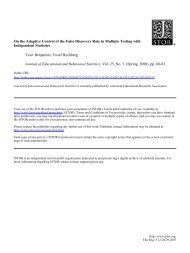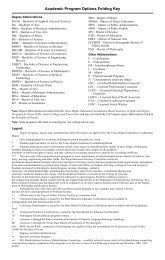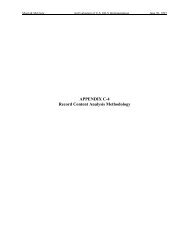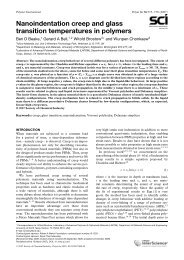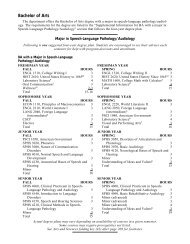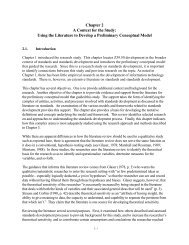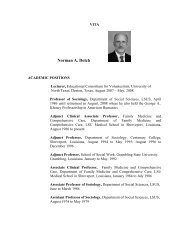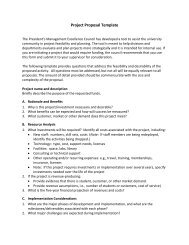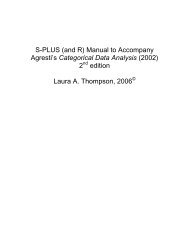Holmbeck, G. N. (1997). - Personal.kent.edu
Holmbeck, G. N. (1997). - Personal.kent.edu
Holmbeck, G. N. (1997). - Personal.kent.edu
- No tags were found...
Create successful ePaper yourself
Turn your PDF publications into a flip-book with our unique Google optimized e-Paper software.
602 HOLMBECKand predictor latent variables were each assessed with 5 indicators).On the other hand, J6reskog and Yang (1996) and Jaccardand Wan (1996) have maintained that fewer terms are needed butthat several constraints must be imposed to test the significanceof the interaction effect (a complete discussion of interactionsinvolving continuous variables is beyond the scope of this article;see Jaccard & Wan, 1996, for a discussion of these issues, aswell as programming examples using LISREL 8).Statistical Strategies for Testing Mediated EffectsAs was done for moderated effects, both regression and SEMstrategies for testing mediated effects are discussed here.Regression Approach to Testing Mediated EffectsAccording to Baron and Kenny (1986), four conditions mustbe met for a variable to be considered a mediator: (a) thepredictor, A, must be significantly associated with the hypothesizedmediator, B (letters refer to variables in Figure 1 ), (b) thepredictor, A, must be significantly associated with the dependentmeasure, C, (c) the mediator, B, must be significantly associatedwith the dependent variable, C, and (d) the impact of the predictor,A, on the dependent measure, C, is less after controllingfor the mediator, B. ~ A corollary of the second condition isthat there first has to be a significant relationship between thepredictor and the dependent variable for a mediator to serve itsmediating role. In other words, if A and C are not significantlyassociated, there is no significant effect to mediate. Such abivariate association between A and C is not required in thecase of moderated effects (nor is it required in the case on anindirect effect, as discussed later).The four conditions can be tested with three multiple regressionanalyses (see Eckenrode, Rowe, Laird, & Brathwaite, 1995,for an example that includes figures as well as a completeexplanation of this data-analytic strategy). This strategy is similarto that used when conducting a path analysis (Cohen &Cohen, 1983; Nie, Hull, Jenkins, Steinbrenner, & Bent, 1975).The significance of the A --* B path (in the direction predicted;Condition 1 above) is examined in the first regression, aftercontrolling for any covariates. The significance of the A ~ Cpath (Condition 2) is examined in the second regression. Finally,A and B are used as predictors in the third equation whereC is the dependent variable. Baron and Kenny (1986) haverecommended using simultaneous entry (rather than hierarchicalentry) in this third equation, so that the effect of B on C isexamined after A is controlled and the effect of A on C isexamined after B is controlled (borrowing from path-analyticmethodology; Nie et al., 1975). The significance of the B ~ Cpath in this third equation is a test of Condition 3. The relativeeffect of A on C in this equation (when B is controlled), incomparison with the effect of A on C in the second equation(when B is not controlled), is the test of Condition 4. Specifically,A should be less highly associated with C in the thirdequation than was the case in the second equation. As Baronand Kenny (1986) discussed, it would be unusual in psychologyfor this A ---, C effect to be r<strong>edu</strong>ced from significance to zero.Thus, the degree to which the effect is r<strong>edu</strong>ced (e.g., the changein regression coefficients) is an indicator of the potency of themediator. Moveover, the significance of the indirect effect canbe tested (Baron & Kenny, 1986). The reader should note,however, that Baron and Kenny's (1986) discussion of Sobel's(1982) significance test only includes an equation that determinesthe estimated standard error of the indirect effect. A recentarticle by Sobel ( 1988, p. 56) includes a more complete explanationof how to apply the significance test and compute confidenceintervals for the indirect effect (see also Colder, Chassin,Stice, & Curran, in press; Ireys, Werthamer-Larsson, Kolodner,& Gross, 1994; Lustig, Ireys, Sills, & Walsh, 1996, forempirical examples).SEM Approach to Testing Mediated EffectsThe logic for using SEM to test for mediated effects is similarto that discussed earlier for moderated effects involving a dichotomousmoderator. Again, the SEM strategy is particularlyuseful when one has multiple indicators for the latent variablesunder investigation.Assuming that there is a latent predictor variable (A), anhypothesized latent mediator variable (B), and a latent outcomevariable (C), one would first assess the fit of the direct effect(A ~ C) model (Hoyle & Smith, 1994). Assuming an adequatefit, the investigator than tests the fit of the overall A ~ B --, Cmodel. Assuming that the overall model provides an adequatefit, the A ~ B and B ~ C path coefficients are examined. Atthis point, the A ~ C, A ~ B, and B --* C paths (as well as theA ~ B --' C model) should all be significant in the directionspredicted (which is analogous to the regression strategy discussedabove).The final step in assessing whether there is a mediationaleffect is to assess the fit of the A ~ B ~ C model under twoconditions: (a) when the A --* C path is constrained to zero, and(b) when the A ~ C path is not constrained. One then examineswhether the second model provides a significant improvementin fit over the first model. As noted earlier, improvement in fitis assessed with a significance test on the basis of the differencebetween the two model chi-squares. If there is a mediationaleffect, the addition of the A ~ C path to the constrained modelshould not improve the fit. In other words, the previously significantA ~ C path is r<strong>edu</strong>ced to nonsignificance (i.e., it doesnot improve the fit of the model) when the mediator is takeninto account (which is, again, analogous to the regression approach).It is also useful at this point to report and comparethe A ~ C path coefficients for when B is, versus when B isnot, included in the model.An additional consideration in using SEM to test for mediationaleffects is the important distinction between indirect andmediated effects. An example is used to highlight this distinction.Capaldi, Crosby, and Clark (1996) recently conducted anEQS-based longitudinal study, where they concluded that theeffect of aggression in the family of origin on aggression inyoung adult intimate relationships was mediated by the level ofboys' antisocial behaviors during adolescence. On the otherhand, Capaldi and her colleagues appear to have found that theAlthough Baron and Kenny (1986) list three conditions of mediation(rather than four), their third condition actually contains two subconditions:the predictor.(A) must be significantly associated with the outcome(C), and this association must be less after controlling for the mediator(B).



